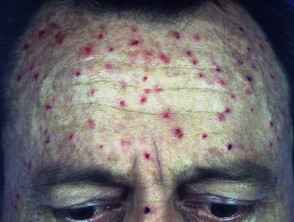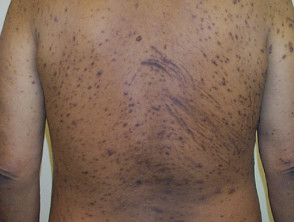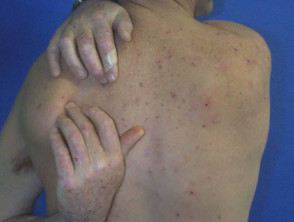What is uraemic pruritus?
Uraemic pruritus (uremic pruritus) is also called chronic kidney disease-associated pruritus (CKD-associated pruritus). Uraemia refers to excessive urea in the blood and occurs when the kidneys stop working (renal failure). Pruritus (itch) is a common problem for patients with chronic renal failure or end-stage renal disease.
It affects about one-third of patients on dialysis and is more common with haemodialysis than continuous ambulatory peritoneal dialysis (CAPD).
Uraemic pruritus (renal itch)
Who gets uraemic pruritus?
The prevalence rates of uremic pruritus are between 20–50% in those with chronic kidney disease, however, the reported rates appear lower in children at approximately 9%.
Uraemic pruritus is not associated with sex, age, ethnicity, duration of dialysis, or cause of renal failure. Pruritus does not arise when uraemia is due to acute renal failure.
What causes uraemic pruritus?
Uraemic pruritus is thought to be due to a combination of factors including:
- Dry skin
- Reduced sweating
- Abnormal metabolism of calcium and phosphorus / raised parathyroid hormone
- Abnormal magnesium and aluminium concentrations
- Accumulation of toxins
- Sprouting of new nerves
- Systemic inflammation
- Co-existing systemic diseases, particularly diabetes and liver disease
- Suboptimal dialysis regime.
Some patients develop acquired reactive perforating collagenosis.
What are the clinical features of uraemic pruritus?
Itch in uremic pruritus most commonly affects the back, however, it can also involve the arms, head, and abdomen. Generalized pruritus is also noted in a proportion of affected patients (20-50%).
Other characteristic features include:
- Itch becoming worse at night, often resulting in disruption of sleep
- Exacerbation of itch with heat and stress
- Relief of itch with physical activity, cooler temperatures, and hot or cold showers
- Fluctuation of symptoms during haemodialysis sessions.
Uraemic pruritus can be associated with several non-specific cutaneous features resulting from repetitive scratching.
These may include:
- Excoriations and dry skin (xerosis)
- Lichen simplex chronicus
- Prurigo nodules.
How do clinical features vary in differing types of skin?
Clinical presentation remains consistent across different skin types and ethnicities.
What are the complications of uraemic pruritus?
Scratching may lead to impetigo (skin infection), prurigo (papules) and chronic, lichenified dermatitis/eczema.
Uraemic pruritus can be very unpleasant; about half of affected individuals become agitated or depressed. Uraemic pruritus in haemodialysis patients is associated with a 17% increase in mortality.
How is uraemic pruritus diagnosed?
Uraemic pruritus is largely a clinical diagnosis, based on a history of chronic kidney disease and onset of symptoms. The commencement of pruritus in patients coinciding with commencement of dialysis, persistence of symptoms, or elevated urea blood levels is consistent with a diagnosis of uraemic pruritus.
Laboratory investigations can help to confirm a diagnosis, investigations may include:
- Blood urea nitrogen
- Parathyroid hormone (PTH)
- Phosphate, calcium, and magnesium levels.
Other dermatological and general metabolic causes of itch may need to be excluded e.g. eczema, scabies, drug-induced reactions, iron deficiency, and thyroid disease.
What is the differential diagnosis for uraemic pruritus?
- Dry skin (xerosis)
- Drug-induced pruritus
- Pruritus of cholestasis
- Paraneoplastic pruritus
- Psychogenic pruritus
What is the treatment for uraemic pruritus?
The first step in treatment is optimising dialysis efficacy. It is also important to attempt to reduce serum parathyroid hormone in order to normalise calcium/phosphorus levels. These methods aim to reduce the underlying cause of itch.
General measures
Supportive general measures to improve symptoms include:
- Regular use of non-soap cleansers and applying emollients, such as cetomacrogol + glycerol or petrolatum several times daily
- Avoiding scratching and keep fingernails short and clean
- Avoiding triggers such as heat and stress.
Topical treatments
Topical preparations for itch are generally sufficient to help improve symptoms, these may include:
- Menthol cream, which provides a cooling sensation to the skin providing relief
- Capsaicin, a compound derived from chillies thought to disrupt the itch signal in nerves, but applicable to limited areas only.
Phototherapy
UVB phototherapy is the mainstay of treatment for severe uraemic pruritus that has not responded to conventional treatments.
Other treatments that have been reported to help some individuals, include:
- Gabapentin and pregabalin in small doses (e.g. 100–300 mg gabapentin, three times weekly)
- Nalfurafine (opioid agonist)
- Difelikefalin (kappa opioid receptor agonist)
- Activated charcoal
- Thalidomide
- Tacrolimus ointment
- Cholestyramine
- Ondansetron
- Cromolyn sodium
- Sertraline
- Montelukast
- Dupilumab.
Oral antihistamines and systemic steroids are generally not effective.
What is the outcome for uraemic pruritus?
Uraemic pruritus can be difficult to alleviate and patients with pruritus often have decreased quality of life such as poor sleep and depression. In cohort studies, it is associated as an independent predictor of morbidity, mortality, and leads to other poor patient outcomes. One study showed moderate to severe pruritus was associated with a 17% increase in mortality rate.
Kidney transplantation is the definitive treatment and usually results in resolution of uraemic pruritus.


